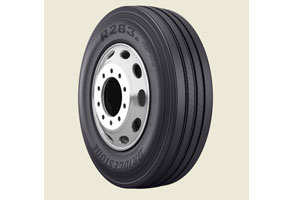Goodyear Demonstrates Fuel Max Tire Line (With Photos)

(Photo gallery above requires Flash to view)
SAN ANGELO, Texas — The Goodyear Tire & Rubber Co. is out to prove that its engineering research and product development efforts can lead to financial savings for truck fleet customers, company managers said here as part of their marketing campaign.
Sales and marketing managers for the company’s commercial tire systems division demonstrated the performance of the Fuel Max line of tires that the company is introducing through the end of this year. The four head-to-head tests against tires made by competitors measured fuel economy, wet-pavement braking, puncture resistance and coasting ability.
To the eye, the tires are still round and black, but the underlying technology is new and advanced, said Brian Buckham, a company general manager, referring to improvements in four types of rubber compounds.
“There’s the cap, the subtread, the cushion and the shoulder, and it takes a lot of technology to bring all four of those together,” Buckham said.
The Akron, Ohio-based manufacturer ran the tests for fleet executives and reporters on March 4 at its 7,250-acre proving grounds.
The three most critical demands on tires are fuel economy, durability and traction, Buckham said, adding that the challenge for tire engineers is to avoid demolishing one of those three pillars for the benefit of the other two.
For the fuel-economy test, Goodyear drove two loaded, 80,000-pound rigs, identical except for tires, on a 120-mile round-trip between here and Abilene, Texas. Over three days of testing, the Goodyear tires got 3% to 4% better mileage.
They drove 3-inch nails into tires and the Goodyear tires stopped leaking more quickly.
A coast-down test got a pair of trucks up to 50 mph and then the drivers shifted into neutral in order to demonstrate low rolling resistance.
The traction test had two trucks enter a wet pavement area — serially, not simultaneously — at 25 mph and then the drivers stomped their brakes to see who could stop most quickly.
Improving fuel economy, even in small increments, is crucial, Buckham said, and he cited a study by the American Transportation Research Institute.
In 2013, ATRI found, tires cost fleets 4.1 cents a mile on average, whereas fuel cost 65 cents a mile that year. ATRI said a heavy-duty truck driving 119,000 miles a year would spend about $77,800 a year on fuel, given 2013 prices.
Therefore, Buckham said, each 1% savings in fuel lets a carrier retain about $778 per year per truck.
The facility here in the western part of the state is the largest of the company’s six international proving grounds. Akron is the only other U.S. location. There are also grounds in Brazil, France, Germany and Luxemburg.
The San Angelo grounds opened in 1944 and feature 58 miles of road with 53 testing surfaces.




